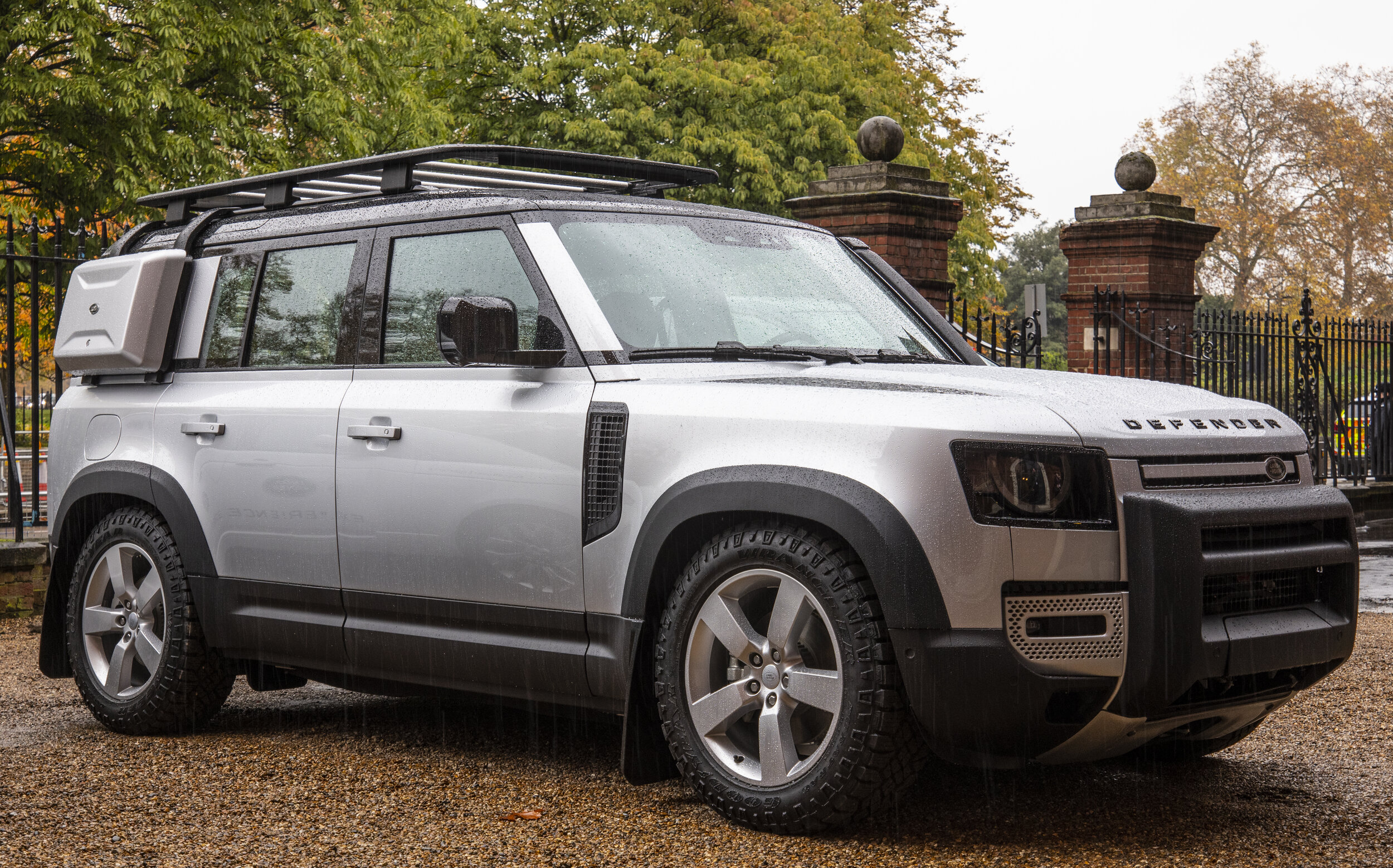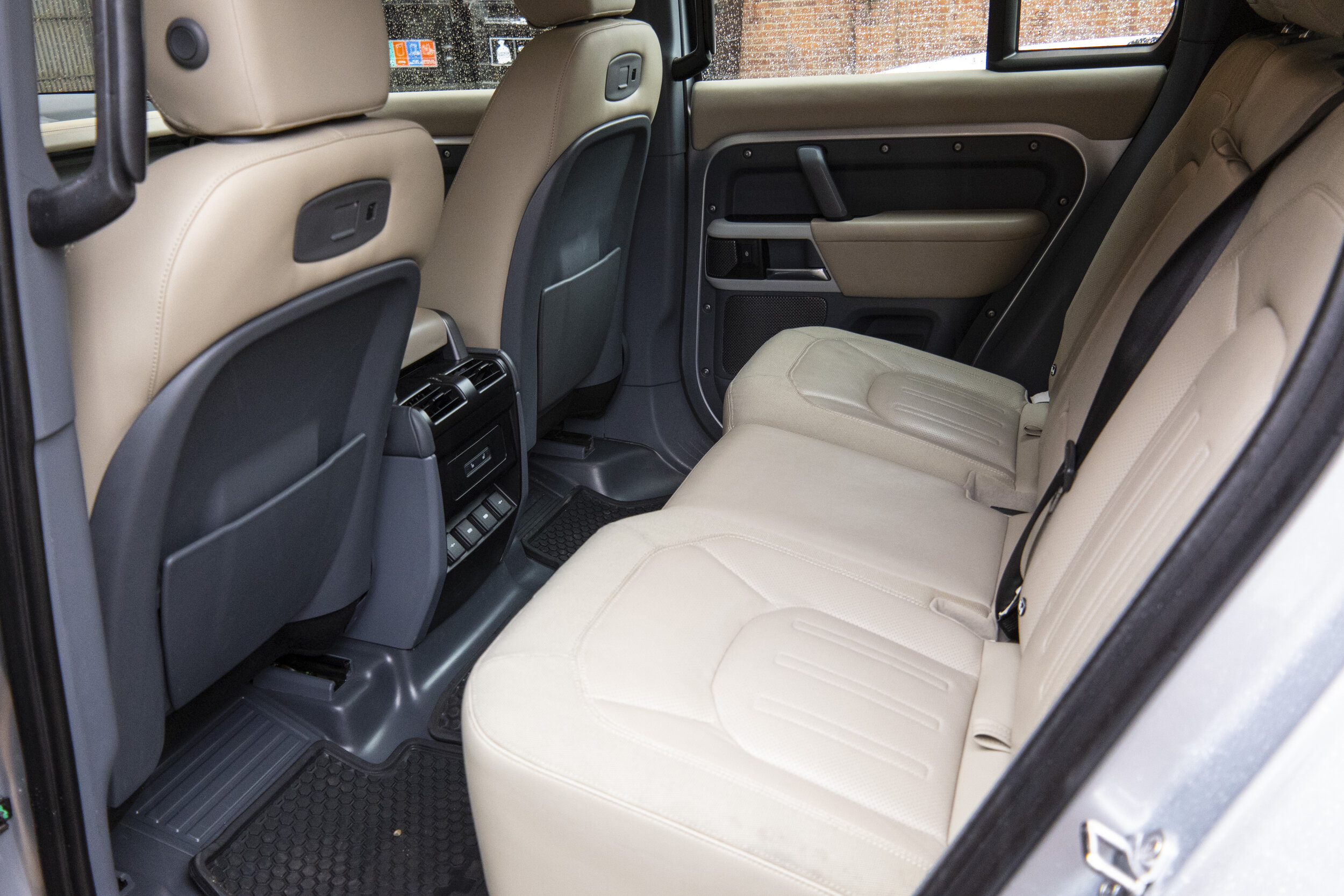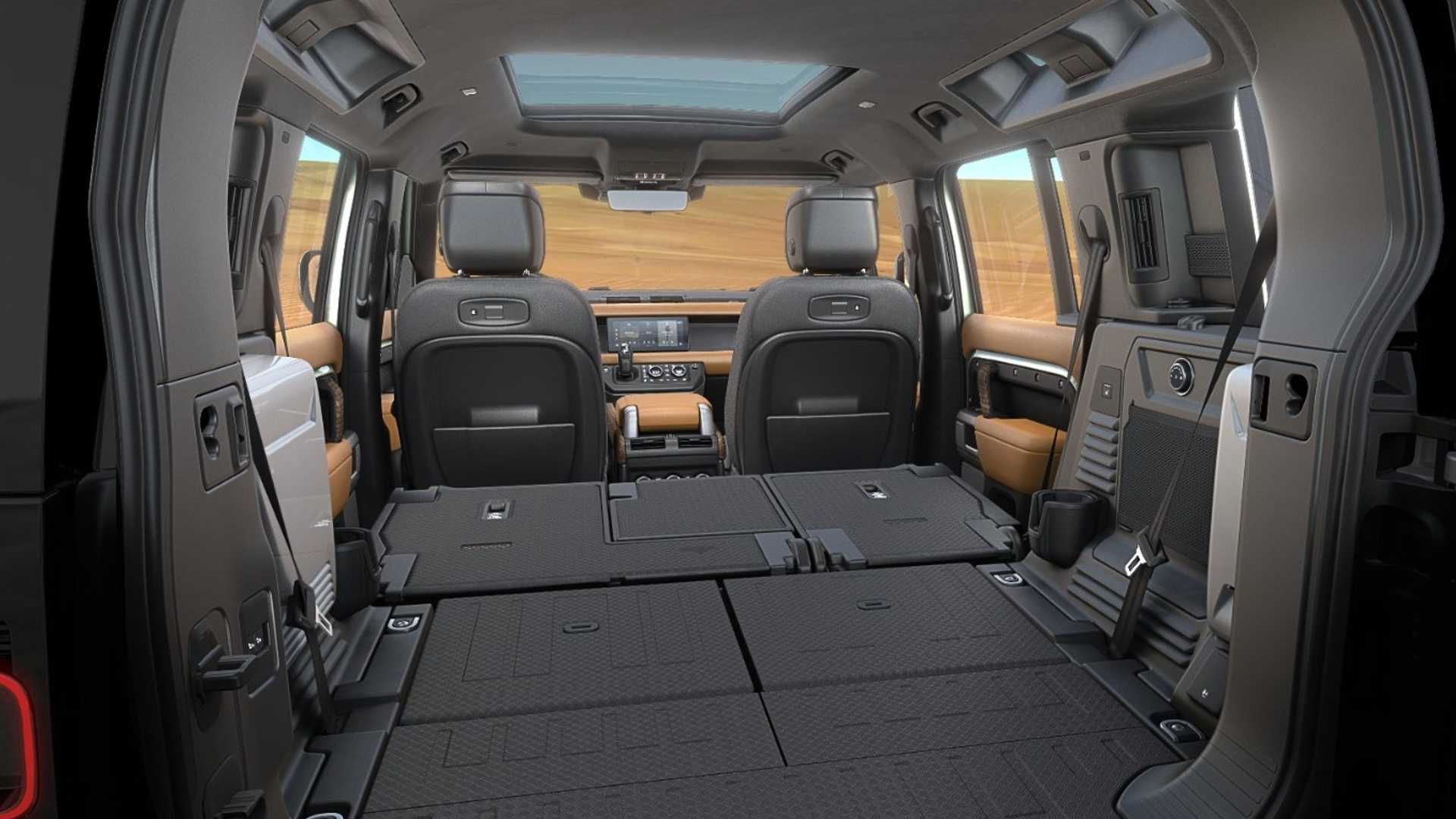
Overland Tech and Travel
Advice from the world's
most experienced overlanders
tests, reviews, opinion, and more
A first hands-on-the-wheel look at the new Defender
The new Defender 110, snoozing at the bottom of its air-suspension travel.
I’m slowly—ever so slowly—creeping toward an actual driving session in the new Land Rover Defender. The latest step occurred in London, where Roseann and I were presenters at the Royal Geographical Society’s Explore event. Thanks to Land Rover’s Stephen Purvis, a still-not-quite-production 110 sat in the forecourt, accessible to us for photographing and sitting in except during the brief period it was strip-searched by a security detail looking for possible explosives prior to a scheduled passage of the Queen’s motorcade. (Any vehicle parked adjacent to that route for several days—even if it’s a new Defender at the RGS—is viewed with suspicion.)
While this one was still unavailable for driving, for the first time I was able to climb around in one, sit in the front and back seats, and get an eyes-on feel for the cargo area. Not to mention an eyes-on feel for the styling. More on that in a bit.
One’s first overwhelming visual impression of the new Defender 110 is of how much smaller it is than the “old” 110.
Except, it isn’t.
In every dimension except height the new model is larger than the old one—especially in length. Compare (dimensions in inches):
Overall length
Old: 184
New: 197
Wheelbase
Old: 110
New: 119
Width
Old: 78
New: 79
Height
Old: 80
New: 77 (Variable with air suspension)
If you’re familiar with the old Defender’s infamous and frequently painful lack of elbow room you might be concerned about the nearly identical width figures. However, the old Defender was widest at the mirrors; the new one is widest in the body. After sitting in the new one I can assure you that “Land Rover Elbow” will be an affliction of the past. There’s much more room—enough so that I simply didn’t notice the driver’s space; it just fit me comfortably with room to spare. In the old Defender—as comfortable as the seat itself was—I was always conscious of having to fit myself in between door, center console, steering wheel, and pedals. Not so in the new one. Legroom was generous for my 5’9”, and since I have no sympathy for tall people I didn’t check beyond that (it’s actually grown by several inches).
Note, too, the significantly longer wheelbase, despite the holdover wheelbase-oriented model designations. I guess JLR figured it would be too confusing to refer to the new models as the 119 and 101 (and the latter could be confused with the old Forward Control 101). I’ve not yet been able to find the length of the new 110’s rear cargo area with the seat down (it folds flat, hurrah!), but it’s long enough to lie down in, and, just as importantly, the layout is wonderfully rectangular, with none of the intrusions that mar the Wrangler Unlimited’s cargo bay. One of the huge strengths of the old 110 was the rectangular cargo area that made it so easy to slot in Wolf Packs or Pelican cases or even jerry cans if needed—or to fabricate custom cabinetry if desired. The new one looks close in this regard. Additionally, the floor is covered with a stout rubber matting, and the sill is level with the back gate opening for easy sweeping out of debris. There are four tie-downs, and a cargo rail is optional.
With the rear seats deployed, there is really good room for two or even three people behind front occupants with their seats adjusted comfortably. It’s an infinitely better arrangement than the old 110’s perch, which put an average person’s head level with the sheet metal above the doors. There is also an optional two-place third-row seat.
Back up to the front seat, and that dashboard—a coarse term for a work of art. Anchored by a crosswise beam structure of magnesium alloy, it incorporates two electronic displays—one in front of the steering wheel and one in the center of the dash. The presentation reminds me of nothing so much as a Series II dash brought into the 21st century. If that was the goal, the (American) designer succeeded brilliantly.
The center screen might be the first touch-screen display I’ve ever seen in any vehicle that actually looks like it belongs there, rather than resembling an iPad velcroed to the dash. Below the center screen is an abbreviated console containing the equally abbreviated shift lever, two blessedly manual dials for climate control, and several related buttons—along with a tiny button that is your entry to the low range of the Defender’s eight-speed automatic transmission, the only one offered. Now that you’ve choked on the idea of a Land Rover Defender without a manual transmission option, note too that those climate-control dials also operate the seat heaters . . . this truly is a new Land Rover Defender.
The driver’s electroluminescent display pops up a tachometer and speedometer when the engine is started, and—three, no four cheers for Land Rover—they are simple, round dials with white lettering on a black background. Perfect. The steering wheel incorporates too many buttons for my taste—hands-free phone controls, plus cruise control and, heh, the button for the steering-wheel heater. (One interesting observation from my press materials: The tachometer shows a redline of 6,800 rpm. Seriously? If that’s genuine I assume it is associated with the P400 straight-six, turbocharged mild-hybrid petrol engine, which boasts 395 hp. Wowsers.)
When Steve Purvis finally dragged me out of the driver’s seat so Roseann could have a look too, I went back to examining the exterior it terms of its promise as a legitimate overland machine.
Comparing approach, departure, and breakover angles, the old 110 is notably superior in approach angle but the new one wins in departure angle. Since the overall minimum on the new one (40º rear) is superior to the overall minimum on the old one (35º rear), I’d give the advantage to the new one. Breakover angle on the old vehicle is slightly superior. This is a function of the new 110’s longer wheelbase—which of course helps that departure angle.
Approach angle
Old: 49º
New: 38º
Departure angle
Old: 35º
New: 40º
Breakover angle
Old: 30º
New: 28º
While the Defender’s basic architecture is the D7 monocoque used in the Range Rover and Discovery, Land Rover claims it is 95 percent new and gives it its own designation, D7x (for, yes, “Extreme,” sigh . . . ). Among other advantages, the revised platform allows the body to be raised by 20mm to increase ground clearance. It is an exceptionally strong structure—torsional rigidity is 30,000 Nm/degree. No body-on-frame design can touch that. The downside, of course, is that the new Defender no longer has that Meccano Set construction suitable for complete disassembly with hand tools under a mango tree in Zambia.
I already knew about the Defender’s superb 900 mm (35.5-inch) fording depth, and the associated wizardry of the Wade Program, which adjusts the air suspension to its highest setting, locks the traction controls, switches ventilation to recirculating, indicates water depth on the center screen, and, finally, drags the brakes lightly for a few yards once clear of the water. This combined with the configurable Terrain Response will certainly help bolster Land Rover’s claim that the new Defender will be significantly more capable than the original.
So: What about that styling? In person the effect of any vehicle is different than it can ever be in photos or even video. Your eye simply takes in more in person than it ever can on a screen.
From the side I like the new Defender a lot—except for the incomprehensible body-color panel stuck in the middle of the greenhouse which, I pray, will be a deletable option. It garishly destroys the linear simplicity of the design, and I cannot imagine why it ever made it past a drunken sketch on a cocktail napkin, quickly rejected the next morning. “What was I thinking?” Of course, if the body-color panel hurts the lines, imagine what the body-colored Flintstones lunch box—sorry, “Gear Carrier”— stuck in the same spot does.
A component of both the “Adventure Pack” and the “Explorer Pack,” the box functions well to raise the drag coefficient while simultaneously lowering visibility out of one side mirror. Whether the trade-off is worth it to carry picnic supplies or (Graham?) a volcano kettle and tea-brewing kit will be decided by consumers, I guess. Here’s hoping some of the more useful components of the “Packs”—such as a built-in air compressor, a portable rinse system for muddy boots or dogs, a full-height cargo barrier, and an exquisitely integrated raised air intake—can be ordered a la carte.
Side view of the “commercial” version shows elegant simplicity . . . and more than a bit of evocation.
As to the front of the new Defender: I laugh every time I pass a Jeep Wrangler equipped with those scowling Angry Birds headlamp covers—and now Land Rover has gone and made the look standard. Urk. As to the rest, my chief befuddlement comes from the apparent lack of any really substantial change from the late and unlamented DC100 concept vehicle, which appeared in 2011 and was universally panned, and which Land Rover “disappeared” as quickly and brutally as Saudi Arabia does an embarrassing journalist. But, to me at least, the front of the new Defender resembles nothing so much as a DC100 Version 1.1. It could be mistaken for any number of Korean cute-utes, and—unlike the ascetic side profile—pays exactly zero homage to the old Defender. The version at the RGS had a large black rubber schnozzle which, in combination with the headlamps, my brain is still struggling mightily not to view as distinctly guppy-ish. ((Go back up and look at your peril.) From the driver’s seat (an important component of front-end “styling” in my book) visibility seemed quite good, although the rounded edges conceal the front corners more than the old Defender’s squared edges, which allowed one to gauge vehicle placement within centimeters. Inevitable to achieve the Defender’s astonishingly low .39 drag coefficient. (By comparison, the drag coefficient on my old Porsche 911SC was .40.)
I found myself with no strong opinions one way or the other on the rear styling, except for wishing that the spare tire had been mounted slightly to one side, as on its predecessor. I’m also not sure about the Mini Me pair of lamps in the fender beside each main cluster. At least one can see a bit of the old Defender’s profile in the “shoulder” just underneath the greenhouse, and from the side its flat back profile is familiar. (If chief design officer Gerry McGovern had used the term “verticality” one more time during his Frankfurt Motor Show intro talk I would have screamed.)
While I’m still ambivalent about some aspects of the Defender’s styling, I’m becoming more intrigued by the vehicle itself. I wasn’t among the poor souls who hoped futilely for a magically renewed old Defender with a 1948 frame design and solid axles; I figured from the start it would be a thoroughly modern, unibody, all-independent-suspension vehicle. Thus I was never disappointed in that regard. There are plenty of fans of the original who wish the company had let the name die rather than sully it on a “poseur” replacement. They’re the ones referring to the new vehicle as the “Pretender” or the “Offender.”
I understand nostalgia, and I certainly understand the loyalty commanded by the original Defender and the Series vehicles that preceded it. But you can stamp your feet and throw your toys out of the crib, or you can accept the reality that the current owners of JLR would have been stupid to consign the name Defender to a trophy case out of some honorable sense of history. Not going to happen. Likewise, given the vicissitudes of the marketplace and Land Rover’s up and down fortunes, the company was never going to go to the massive expense of engineering a ground-up replacement with a separate chassis and beam axles when they have monocoque architecture and plug-and-play all-independent suspension already available.
Is the new Defender going to be a competitor for Toyota’s mighty, body-on-frame, solid axle 70-Series Land Cruiser, or the stripped versions of the equally mighty Mercedes G-Wagen? No. Land Rover has ceded that market, possibly forever. We need to modify our expectations.
What I hoped for was a Defender that, while brought up to date with 21st century design and technology, would retain its suitability as a vehicle for long-distance exploration and rugged use—and, I’d might as well say this, would also be brought up to date with regards to the reliability of its competition. In the U.S., in terms of those in the market for an overlanding vehicle, I think that competition is going to be the 4Runner, the Pathfinder, the Jeep Rubicon Unlimited—even quad-cab versions of the Colorado, Tacoma, and Frontier.
I suspect a new Defender 110 will cost more than any of them, so that competition will be interesting to watch. The Defender, on paper at least, should be superior off-pavement to the 4Runner, the Pathfinder, and the pickups, and more sophisticated than the Wrangler (with a far higher payload). The big remaining question will be reliability—a question that will only be answered after users have put a few million miles under the wheels of the new “Pretender.”
And at that it was time to head back inside the august halls of the RGS.
Some (positive!) thoughts on the new Defender
The Defender’s “Commercial” configuration shows promise for those wanting a basic overlanding vehicle.
Now that the wait is over, and Land Rover Design Director Gerry McGovern’s stupefyingly uninspiring introduction at the Frankfurt Auto Show is behind us, and the bile from thousands of defenders of the original Defender is pouring down on the “Pretender” or “Offender,” as it’s been variously dubbed, I thought I would get beyond my own reservations regarding what I think of as the DC100 Version 1.1 styling, and look at the positive side of the new design.
We’ve known for a long time that the new Defender would be an about-face from the original: monocoque construction instead of body-on-frame, all-independent suspension rather than solid axles, efficient aerodynamic design rather than a box on top of a box. So it’s time to let go of those paradigms. The question is, is the new Defender capable of filling the role of a long-distance traveling vehicle, or even a true expedition machine?
Note the lead photos above, which show the 90 and 110 in what Land Rover calls the Commercial configuration. Steel wheels (albeit, at 18 inches, larger diameter than optimum), coil springs, simplified interior, and, in the 110, a cargo capacity of up to 900 kg (1,980 pounds). That is pretty close to the previous 110, and far above, for example, the Jeep Wrangler Rubicon—in fact just about double. Also, from a pure looks standpoint, the Commercial’s solid white back quarter looks infinitely more handsome than the regular model’s bizarre body-color square covering the massive C-pillar, a design flub that completely ruins the linear continuity of the greenhouse. (I understand the body-color panel might be an option; if so it should be called the “Uglify package.”)
Look at the cargo area of the 110. The rear seats fold completely flat—three cheers to Land Rover for making that happen.
There’s a lot of side intrusion into the space due to those C-pillars, which house AC ducts (note how they also bifurcate the alpine windows above them), but it looks long enough to lie down in, one of my personal criteria for a long-wheelbase overlanding vehicle—for those midnight camps after a long drive when you just need to sleep. However, the protruding hinges on the two-thirds split seat look like they’d dig into the back of anyone lying on that side. Still, overall a practical-looking cargo area, with less intrusion than the interior roll cage and speaker housings on the Wrangler Unlimited.
In terms of capability, the Defender should shine. The approach and departure angles on the 110 (38 and 40 degrees, respectively) compare favorably with those of the Wrangler Rubicon Unlimited (44 and 37). The breakover angle is markedly superior at 28º versus 22.6º.
The Defender boasts a world-class fording capability of 900mm (just half an inch under three feet). Not only that, the Wade function on the Terrain Response system will automatically soften throttle response, lock the driveline, switch the ventilations system to recirculate, raise the (air) suspension to its maximum height, display the water depth on the infotainment screen, and drag the brakes slightly for a few meters after exiting the water, to dry them. Astonishing.
Speaking of Terrain Response—Land Rover’s pioneering and much-copied user-selectable system that alters vehicle dynamics to accommodate varying terrain—the Defender’s system will also be user-programable to suit individual driver preferences and experience.
Land Rover claims an astounding 45º side slope capability and a 45º ascent capability for the new Defender. I seriously doubt any owner will approach either of those limits. And never in any company’s literature have I seen so many quantified references to strength and durability testing as I found in the full-length technical brochure for the Defender. For example, in regards to the vehicle’s double wishbone front suspension and integral-link rear suspension, the brochure says the Defender “withstood repeated 200mm (eight-inch) kerb strikes at 25 mph.” Say what? Also, “the wheels can withstand up to seven tonnes of vertical load into the body.” And, “The monocoque body construction developed for new Defender is the stiffest aluminium body Land Rover has ever produced and able to withstand 6.5 tonnes snatch load through the recovery points. “
Returning to the interior, I think the dash layout might be my favorite feature of the new Defender. It is simple, elegant, and functional. To me it looks exactly like the 21st-century descendant of the Series II dash. Even the ubiquitous center touch/infotainment screen looks like it belongs there—something I can’t say about several $120,000 luxury sedans. Yes, the steering wheel has too many buttons, but most of them can be ignored anyway. Several features reveal genuine consideration to actual real-world use. Got cargo piled so high in the back it blocks the center rear-view mirror? Flip a switch and the rear camera projects the view into the mirror. Nice.
And yes, gone forever are the three transmission/transfer case levers and their red and yellow knobs. In fact, given the dash mount of the automatic gear selector, I doubt the Defender is configured to ever accept a manual transmission. Which . . . and I never thought I’d write this . . . is a good thing. Modern automatic transmissions are superior to their manual counterparts in virtually every way, including power delivery and fuel economy, not to mention the ease of driving on slow rough tracks or the magic of hill-descent control. The new Defender is never again going to be a vehicle an owner disassembles to repair or rebuild under a mango tree in Zambia, so the added complexity of an automatic transmission is really not an issue.
One factor in the suitability of a vehicle for long-distance journeys is often overlooked, and that is comfort. To say the new Defender will eclipse the old one in this regard is stating the obvious. At a guess I’d say the new one will double the comfortable daily mileage an owner can expect to cover when transits necessitate a dawn to dusk marathon.
The remaining factor, of course, is reliability, the one area in which Land Rover has long taken a fourth or fifth place to its Toyota, Nissan, Mercedes Benz, and Jeep competition. I can only hope Gerry McGovern and his team fully grasped the critical need to get that part right this time.
I know one thing: After thoroughly studying the detailed specifications and capabilities of the new Defender, I find myself for the first time genuinely excited for an opportunity to drive one.
The new DC100 . . . I mean Defender . . . is here.
In 2011 Land Rover unveiled a concept for a new Defender called the DC100. The looks of the prototype were so universally panned that it vanished within weeks and was never seen again.
Until now.
Eight years later Land Rover has unveiled the actual new Defender. And, pardon me if I’m being myopic, but—at least in photos—I’m having a devil of a time distinguishing a revolutionary change in styling from that short-lived concept.
More soon about the advertised capabilities—which are impressive—and the option packs, some of which border on eye-rolling in their pandering to millennials seeking to appear more rugged than they really are. I don’t think I could stand to tick an option box called the “Adventure Pack.”
Hint: When using “Search,” if nothing comes up, reload the page, this usually works. Also, our “Comment” button is on strike thanks to Squarespace, which is proving to be difficult to use! Please email me with comments!
Overland Tech & Travel brings you in-depth overland equipment tests, reviews, news, travel tips, & stories from the best overlanding experts on the planet. Follow or subscribe (below) to keep up to date.
Have a question for Jonathan? Send him an email [click here].
SUBSCRIBE
CLICK HERE to subscribe to Jonathan’s email list; we send once or twice a month, usually Sunday morning for your weekend reading pleasure.
Overland Tech and Travel is curated by Jonathan Hanson, co-founder and former co-owner of the Overland Expo. Jonathan segued from a misspent youth almost directly into a misspent adulthood, cleverly sidestepping any chance of a normal career track or a secure retirement by becoming a freelance writer, working for Outside, National Geographic Adventure, and nearly two dozen other publications. He co-founded Overland Journal in 2007 and was its executive editor until 2011, when he left and sold his shares in the company. His travels encompass explorations on land and sea on six continents, by foot, bicycle, sea kayak, motorcycle, and four-wheel-drive vehicle. He has published a dozen books, several with his wife, Roseann Hanson, gaining several obscure non-cash awards along the way, and is the co-author of the fourth edition of Tom Sheppard's overlanding bible, the Vehicle-dependent Expedition Guide.
























